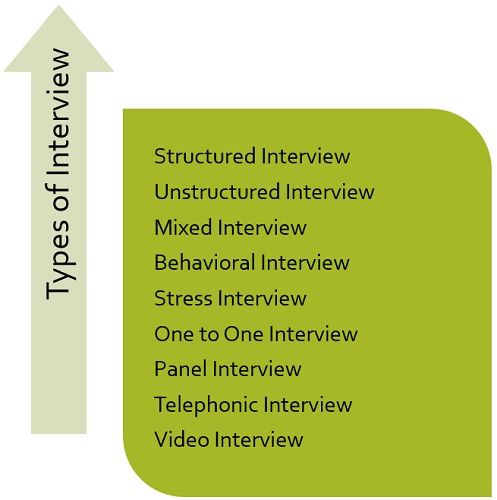Definition: Interview refers to a formal, in-depth conversation between two or more persons, wherein the exchange of information takes place, with a view of checking a candidate’s acceptability for the job.
Objectives of Interview
- To evaluate the applicant’s suitability.
- To gain additional information from the candidate.
- To provide general information about the company to the applicant.
- To create a good image of the company, among applicants.
It is an effective tool for selection. It is two-way communication between interviewer and interviewee, wherein the former seeks information, by way of questions and the latter provides the same, through his/her verbal responses. However, the information flows in both directions. In this way, the hirer learns about the applicant and the applicant also get a chance to know about the employer.
Types of Interview
The various types of interview are explained hereunder:
- Structured Interview: The interview in which preset standardised questions are used by the interviewer, which are asked to all the candidates. It is also known as a patterned or guided interview.
- Unstructured Interview: The unstructured interview is one that does not follow any formal rules and procedures. The discussion is free-flowing, and questions are made up during the interview.
- Mixed Interview: It is a combination of structured and unstructured interview, wherein a blend of predetermined and spontaneous questions are asked by the interviewer to the job seeker. It follows a realistic approach which allows the employer to make a comparison between answers and get in-depth insights too.
- Behavioural Interview: It is concerned with a problem or a hypothetical situation, given to the candidate with an expectation that he/she would solve. It aims at revealing the job seeker’s ability to solve the problem presented.
- Stress Interview: The employer commonly uses stress interview for those jobs which are more stress-prone. A number of harsh, rapid-fire questions are put to the interviewee with intent to upset him. It seeks to know, how the applicant will respond to pressure.
- One to one Interview: The most common interview type, in which there are only two participants – the interviewer (usually the representative of the company) and interviewee, taking part in the face to face discussion, in order to transfer information.
- Panel Interview: Panel interview is one, in which there is a panel of interviewers, i.e. two or more interviewers, but limited to 15. All the members of the panel are different representatives of the company.
- Telephonic Interview: Telephonic interview is one that is conducted over the telephone. It is the most economical and less time consuming, which focuses on asking and answering questions.
- Video Interview: An interview, in which a video conference is being employed, to judge or evaluate the candidate. Due to its flexibility, rapidity and inexpensiveness, it is used increasingly.
Halo Effect
Halo effect refers to cognitive bias, wherein the interviewer makes a judgement about the applicant’s overall potential for the performance of the job, considering a single characteristic, like the way he/she talks, sits, dresses, etc.
Interviews also have several shortcomings, such as lack of reliability, i.e. no two interviewers give similar points to an applicant after the interview. Further, lack of validity and biases of interviewers may also trouble interview.

anand says
Best articles i never seen in any sites. these are easy to understand…. thanking you
Jia says
Informative article👏
Vyshnav says
Thanks
Nuwahereza simon says
So helpful
Imavu says
This is really the best of all. It’s well explained in summarised form easy to understand.
Menaka says
Very helpful thanks for you
Good job….
Chandrika Solleti says
Very informative for my job skills and also to understand the concept in detail, Thank You
Maryam Razzaq says
Easy And Informative Article
Thank you so much 👏